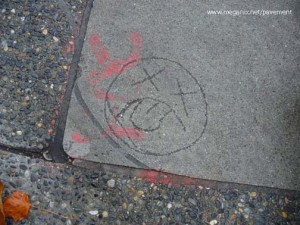The signs, symbols and graffiti on the ground are all evidence of a territorial battle that is being waged among government authorities, property owners, motorists, cyclists and pedestrians. Now the stencils themselves are getting in on the act. It is clear that this walker has cracked up and has said something sharp to the bicycle. But a zealous graffiti obliterator has painted over his speech balloon and now we’ll never know what it was he said.
These particular stencils are on a pathway in Cadigal Reserve in Summer Hill. The pathway continues along beside Hawthorne Canal, which eventually runs into an arm of Parramatta River.Â
The canal has a history of successive waves of pollution. Originally a stream called Long Cove Creek by early European settlers in Sydney, by the late 1800s it was fouled with house slops and the run-off from factories and slaughterhouses. The stink that it gave off was considered to be a health hazard and eventually it was excavated, re-aligned and lined with concrete in 1895 and renamed Hawthorne Canal.
But over the years the stormwater it collects has still been polluted with leaking sewage and dirt, horse manure, oil, chemicals, plastics, heavy metals and garbage washed off the roads and nearby rubbish dumps. And then, some time in 1990s, the canal was subjected to what some people regard as visual pollution – graffiti.
Taggers and graffiti artists continue to express themselves on the walls and under the bridges there. Their marks have spread to the pathway beside the canal. Government authorities and a bush regeneration group have done much to improve the banks of the canal in recent years, so it is understandable that they might want to remove ‘unsightly’ graffiti from the asphalt. They can’t win though. More pavement graffiti has appeared since the last applications of grey paint. But I wish I had been there before they covered up that pedestrian’s outburst.
(Some of the information for this post was obtained from Hawthorne Canal – the history of Long Cove Creek, written by Mark Sabolch and published by the Ashfield & District Historical Society in association with the Inner West Environmental Group in 2006)



 How do I know when the sidewalks of Vancouver were last paved? Easy. The year is impressed into the concrete. Near one of these imprints I found an impromptu wet cement drawing. This piece of pavement graffiti was the first one I photographed after arriving in Vancouver for a conference. It reflected how I felt after the 14-hour flight from Sydney.
How do I know when the sidewalks of Vancouver were last paved? Easy. The year is impressed into the concrete. Near one of these imprints I found an impromptu wet cement drawing. This piece of pavement graffiti was the first one I photographed after arriving in Vancouver for a conference. It reflected how I felt after the 14-hour flight from Sydney.
 How quaint, I thought. Someone has etched an autumn leaf in wet cement on the sidewalk. Then I noticed another, and then a whole slew of them under an almost bare street tree.
How quaint, I thought. Someone has etched an autumn leaf in wet cement on the sidewalk. Then I noticed another, and then a whole slew of them under an almost bare street tree. Vancouver has many examples of street art, most of it official, some of it unofficial (though, as you would expect, graffiti mostly occurs at the fringes of Downtown, not in the centre).
Vancouver has many examples of street art, most of it official, some of it unofficial (though, as you would expect, graffiti mostly occurs at the fringes of Downtown, not in the centre). I love the pitted texture of this old bicycle symbol. It’s on a shared footpath (footpath?) near Erskineville Station. In the foreground of the wider shot there is a tag – or maybe it’s just a spill.
I love the pitted texture of this old bicycle symbol. It’s on a shared footpath (footpath?) near Erskineville Station. In the foreground of the wider shot there is a tag – or maybe it’s just a spill.